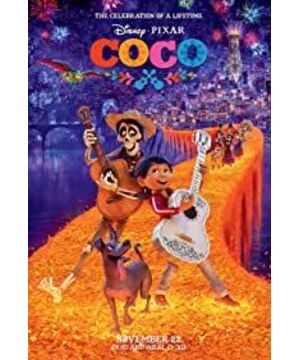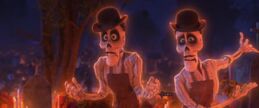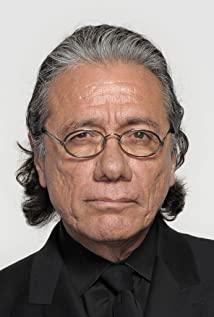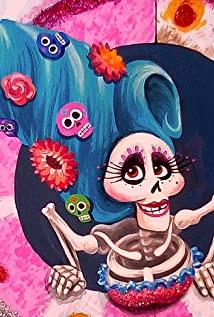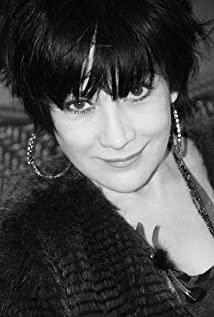Because of such a movie, I have a deep sense of identity with the upcoming Day of the Dead in the country of Mexico . The chief creators of Pixar have done a lot of preliminary preparations. Six years of production has allowed the film to beautifully incorporate a lot of Mexican elements and tell a moving story. As the director said, "I want to show a Mexico that is different from the news", if this article can give you a little bit of understanding of Mexico, or you can have some wonderful experiences of "understanding this stalk" when watching a movie. , It's a very happy thing.
The paper-cutting (papel picado) at the beginning of the movie . This type of paper-cutting is very common in Mexico. When I visited a manor a few days ago, because a wedding was about to be held, the corridor was covered with paper-cuts with ring patterns, pure white, for them In terms of symbolizing holiness and happiness, it is a bit like Japan, but the opposite of China. During festivals (National Day, Day of the Dead, etc.), many colorful paper-cuts are hung along the street.
Mexicans really like colors. They paint their houses colorfully, and many blocks are even embellished into a beautiful landscape.
Then came the tamal that grandma told grandson to eat. It is a traditional Mexican food. It is a thick layer of cornmeal wrapped in chicken or pork, vegetables, chili, sauce, etc., wrapped in corn husks and steamed, much like Chinese food. Zongzi. Although corn is a staple food in Mexico, a thick layer of cornmeal is still a bit incompetent. It can be said to be one of the most disliked things to eat in Mexico (cover your face). According to data, it is also eaten in many countries in Central and South America. "Zongzi", but the method and materials are slightly different.
This big family is called Rivera, who makes shoes for generations (Un Rivera es un zapatero hasta huesos jajaja). This is actually also very related. Until now, the backbone of Mexico’s economy has been family-based small and medium-sized companies . In the past, it was a family-owned workshop. And in the past, most of them made shoes.
In this family, Mamá Imelda raised her daughter alone, and also established the foundation for the survival of the entire family. This is also common in Mexico. Although Mexico is very "machismo" (machismo), it more often reflects the matriline. The characteristics of society (un país matriarcal), even more so decades ago, the female role assumes greater responsibility in the daily and major affairs of the family, just as mamá Imelda said when she confided,
"He wants to sing, and he wants to go to a farther stage. What I think is to take root in life. Daughter is more important than music."
The mother who lives in the house is an old man in her nineties, and her usual life is similar to that of mamá coco. Our several conversations are basically repeated content hhh, but in one chat, she said "los hombres no valen nada" "(Men are of no use) When young, women have to do everything and take care of the inside and outside of the home. Men are basically "hands-offs", which coincides with what is shown in the movie.
The square that appears in the film is called plaza de mariachi. Mariachi is a traditional Mexican music form. People who perform and sing will wear a unique hat called sombrero. The brim is large and can block the sun. hhh
(The Spanish version of recuérdame, como loco, etc. are all very good songs in the movie. The Mexican sings are full of air and very affectionate, and it is much better than the English version of chanting and singing!!)
In the film, people in small towns hold many activities in the square. This is the daily life of a Mexican village. A village has a small activity center where people gather and entertain. It feels very similar to rural China. In fact, until now, the village is still the administrative and geographic unit where most Mexicans (especially in the south) live. There are more than one hundred magic towns (pueblo mágico) in Mexico . Handicraft is a profession.
The Ernesto de la Cruz that appears in the film is based on Pedro Infante, a well-known actor and singer from the Mexican film golden age (siglo de oro del cine).
Mamá Imelda, the oldest family member in the film, Miguel's great-great-grandmother, Hector's wife, is based on Maria Félix, a famous actor from the golden age of the film.
By the way, in the film, the little boy said, "We are probably the only family in Mexico that doesn't like music." This sentence is very accurate. Mexicans really love music , and as far as people I know, young People also like the traditional mariachi, here is a song las mañanitas that Mexicans will sing on their birthdays
(Does not support my link, so angry)
(Btw, the town where the living people live in the movie is called Santa Cecilia, which does not exist, but this name is the name of the patron saint of music in the Mexican faith)
There is a funny dog (Dante) in the film. The dog is also a story-telling existence on the Day of the Dead. People regard it as the leader of the soul (guía de espíritus). After death, people need a dog to lead them there. In another world, this dog can’t be too dark, because it’s too dark, and people won’t see them on the way to another world; nor can it be too white, because dogs that are too white are not willing to go to dirty places, yes, black and dirty It is everyone's perception of this road.
Interestingly, dogs seem to have always been an important role in Latin American civilization. I went to Teuchitlan in Jalisco some time ago. The locals believed that the civilization (la tradición Teuchitlan) that existed there was better than the Mayan civilization and the Aztec civilization. It existed a lot earlier, about 500 BC. Coincidentally, there is always a dog in the tomb reshaped by archeological deduction. The rich people use real dogs, and those who have no money use porcelain to make them look like dogs. Be buried with the owner like our terracotta warriors.
It is said that the prototype of the Undead World is Guanajuato, Mexico . The latter has just been rated as one of the top ten travel destinations in the world by lonely planet. It has beautiful scenery and good public security. It is a town that is the main tourist destination in Mexico. In fact, the film has a very clever design. A large skyscraper in the world of the undead shows the present Mexico from top to bottom: the underdeveloped southern part, the bustling commercial central part and the industrially dense northern part.
People in the undead world have to walk on a bridge made of marigolds (flores de cempasúchil) , and Miguel should pray with marigold petals to return to the world. It is said that marigolds symbolize the rays of the sun , the origin of all things, and guide the undead on the way home, so it is a typical decoration for the Day of the Dead.
The little girl who went with her said that the thing that touched her the most was that her dead relatives could really go back to the world through such a bridge.
After entering another world, the oldest mamá imelda in this family has a mount, and this mount is also very backed , called alebrije . The version of the story I saw was a craftsman who was very sick and burned. When it was very powerful, I always dreamed of a group of monsters roaring at alebrije. After waking up, he made out the things in his sleep day and night, and started selling them, until Frida and Diego came to him to buy in large quantities, and alebrije did so. Become Mexico's "net celebrity", and then gradually became a symbol.
Speaking of the two couples Frida and Diego , they also exaggerated their sense of existence in the film. This should be quite famous, so I won’t go into details~
When entering the Ernesto party, a man named el Santo appeared . The security guard expressed respect for him. This is also based on evidence. El Santo is the greatest athlete in the history of Mexican lucha libre , and lucha libre is also very important in Mexican social life. The important part is free fighting. It seems violent to hear the name, but in fact, after I went there, I found that he is very different from boxing. It is not for the purpose of competition. More often it is a cooperative performance of two people (but also very distracted. ), good-looking actions and interesting scenes are all things that luchador on the stage should consider. Win or lose is not important. The important thing is to make everyone happy and enjoy watching.
Before going to see lucha libre's performance, the host told me excitedly, there you will see lo mexicano (real Mexico)
As soon as we entered, the people in the stands yelled "chinitas" and "abren los ojos" (open your eyes?) at the group of us. Although these words are rude, they are not malicious. It can also be said to be a small embellishment of the whole performance. The mutual attacks on stage and off stage are all part of the performance. For them, watching lucha libre and yelling swear words is part of their daily decompression, so of course, "being wild is enough to have fun." ".
Later on, the deceitful "de la cruz" wanted to deal with Miguel and Hector, and the defender threw them into an underground spring (cenote) . The underground spring is a well-known geographic landscape in Mexico, which can be called a part of the Yucatan Peninsula. Great feature. The Maya believed that the underground spring was the entrance to the world of the undead, where they performed "sacrificio humano" (sacrificio humano)
In the end, the whole story takes place one day and one night on the Day of the Dead (día de muertos) , and this day is an extremely important day for Mexicans. Because the relatives who died on this day will return to the world, reunite with the living, and cross the boundary of life and death. This also explains why Mexicans do not regard death as a painful thing, because people after death will be in another The world is alive and well, singing and dancing, enjoy their fiesta as always, and will come back once a year to reunite with them, so there is no need to say goodbye.
In 2008, UNESCO listed the Day of the Dead as one of the intangible cultural heritage of mankind.
The memorial of the dead by the Mexicans can be traced back to the Indian civilization . According to the data, during the Aztec civilization, there are at least 6 celebrations related to the dead ancestors every year (18 months). After the Spanish colonists arrived, In order to better carry on colonial rule, the celebration traditions of these primitive tribes were integrated with the traditions of European religions, and then passed down.
On the Day of the Dead, people will dress themselves up as skeletons (like Hector drew Miguel in the movie) and carnival with the unseen dead.
The directors describe the country as a “vibrant country filled with culture and warm people”
I totally agree with it.
About the movie
The film is intertwined with two cores. On the surface, the whole story is strung with the boy 's love for music , but emotionally, it firmly holds the connotation of the Day of the Dead and the emotional core of the Mexicans- family affection .
Family is more important than dreams.
Why do people celebrate the Day of the Dead? In order to reunite with family and friends, in order to connect with each other, in order to have the wonderful moments we have and are having together, whether it is life or death. So, "Before the memory of love disappears, please remember me" . Mexicans have a really strong sense of family. They feel incredible about Chinese college students living in a dormitory for four years and leaving home all the year round.
"The real death is that no one in the world remembers you"
(Ps. In the film, there is an undead who disappeared because he was completely forgotten. After his death, the close-up of the wine glass is Mexico’s national wine tequila.)
There is a moving change in the movie. At the beginning, the little boy Miguel didn’t identify with the Day of the Dead, and he didn’t agree with the ancestors on the altar. But at the end of the movie, he hugged a child and told him that these were not just photos. , Is our family.
In recent years, under the influence of the strong culture of the host country, many young people prefer to spend Halloween with their friends. This film also seems to be deliberately arousing the resonance and recognition of the traditional family holiday of the Day of the Dead (día de muertos) .
Welcome everyone to play or add in the comment area~
View more about Coco reviews


